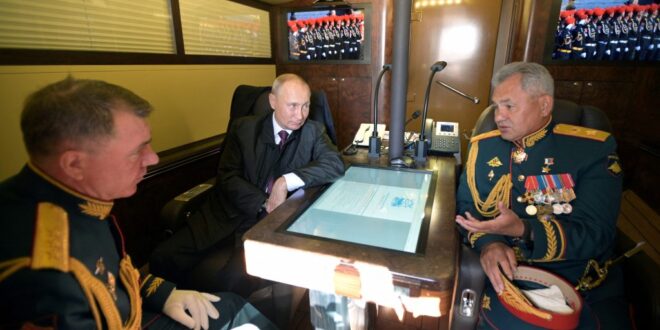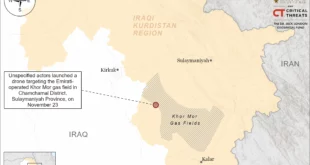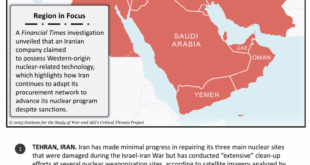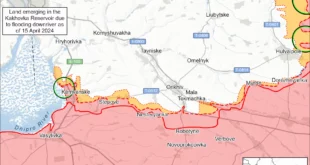Escalation is a cornerstone of Russian President Vladimir Putin’s strategy in his war against Ukraine, especially as Ukrainian counter-offensives have steadily rolled back Russian gains. As his setbacks mount, it’s important to address some key questions: How can Ukraine and its partners prevent further escalation to the nuclear level while denying Russia a chance to seize victory from the jaws of defeat. And if such escalation occurs, how should the West respond?
After the initial attack on Kyiv and other major Ukrainian cities, Russian escalation has occurred in several phases in response to its losses on the battlefield. These include the artillery assault in the Donbas, Russia’s mobilization, illegal annexations and martial law in four oblasts, probable sabotage of the Nord Stream pipelines, and massive recent attacks on Ukraine’s energy infrastructure.
In each case, Russian escalation was aimed at gaining battlefield advantage and breaking Ukraine’s will. It has not succeeded in either purpose. Nevertheless, Putin will undoubtedly escalate again in the face of failure to achieve his shrinking war aims and to stave off strategic defeat. Ignoring his threats to escalate further, including through the use of nuclear weapons, is not sound policy. Instead, measures need to be in place to deter and, if necessary, respond to this threat in ways that impose heavy costs for Russian misbehavior but do not further escalate the conflict.
Further escalation will depend on the battlefield situation
Ukraine has used the arms the United States and its NATO allies have provided to launch successful counter-offensives in the Kharkiv region and in parts of the Kherson region, and it has clawed back some of Russia’s mid-summer gains in Donbas. The jury is out as to whether these events will lead to a collapse of the Russian military effort in Ukraine or to a prolonged stalemate. While there are many signs of potential Russian military collapse, Russian forces are now digging in with the natural advantages of defensive positions. With more competent leadership under General Sergei Surovikin and additional manpower through mobilization, Moscow may be able to break the Ukrainian momentum and sustain a stalemate for some time.
Putin is unlikely to escalate to the tactical nuclear level if his forces manage to stabilize the battle lines. In that case, he would probably pursue his objectives through a war of attrition, continued efforts to impose a ceasefire, and attempts to divide NATO with calls for negotiations that would prevent Ukraine from recovering any more lost territory.
Under these circumstances, the United States and NATO should continue their successful policy of arms transfers to Kyiv, focusing on increased numbers of high mobility artillery rocket systems (HIMARS), long-range artillery, offensive drones, modern tanks, and armored fighting vehicles to retake lost territory. In addition, they should supply air-defense and counter-drone systems to deal with Russia’s attack on Ukrainian cities. They should continue to do their utmost to achieve a Ukrainian victory—at least the recovery of most territory occupied since February 24 while avoiding escalating to a NATO-Russian war. Despite Russian rhetoric about a “proxy war” with the United States and NATO, Putin is keen to avoid direct NATO involvement, especially given the decimation of Russian equipment and manpower.
Can negotiations prevent further escalation?
The battlefield situation is not ripe for negotiations at this time. Russia has the largest incentive to establish a ceasefire that would allow it to retain Ukrainian territory it now occupies and that it risks losing to the Ukrainian counter-offensive.
Since the Kharkiv offensive, Ukraine has been on a roll militarily and has little reason to negotiate given Russian brutality against civilians, rampant war crimes, and efforts to eradicate Ukrainian national identity. Ukraine has also shifted its declared war aims from recovering all territory occupied since February 24 to recapturing all territory lost since 2014, including Crimea. There is zero interest in Kyiv in giving Putin any concessions when Russia is still demanding Ukraine’s political subjugation and demilitarization. Washington has stated that it will leave it to Ukraine to decide if and when to negotiate, effectively letting Ukraine strengthen its negotiating leverage on the battlefield before sitting down at the negotiating table.
If Ukraine can recapture more territory quickly, without further Russian escalation, then negotiations may not be needed. However, the need for a negotiated solution might increase if Russia can create a stalemate on the battlefield. If Ukraine continues with its successful counter-offensives, Putin might seek to force negotiations on Kyiv by further escalating the conflict.
The history of the Cuban Missile Crisis teaches us that US President John F. Kennedy was able to negotiate the removal of Soviet missiles from Cuba by showing strength with a military quarantine but also by providing Soviet leader Nikita Khrushchev with a fig leaf, the removal of obsolete Jupiter missiles from Turkey. Should negotiations be required to end the Ukraine war, a similar formula may be needed.
For any negotiations to work, better channels of communication to the Kremlin will also be needed. Secretary of Defense Lloyd Austin has just taken one important step in that direction with his recent phone conversations with Russian Defense Minister Sergei Shoigu. More direct communications are needed to reduce the danger of unintended escalation.
Possible options for Russian nuclear escalation
Putin has threatened further escalation, implying that he might use nuclear weapons and stating that he is “not bluffing.” But Moscow has not indicated what the threshold for such escalation might be—it may not know itself—and it may be a calculated bluff. Potential triggers for further escalation might include a Ukrainian victory in Kherson, additional successful Ukrainian military strikes or sabotage attacks in Crimea, the collapse or mass desertions of whole Russian military units in Ukraine, attacks on Russian cities by Ukrainian forces, the provision of long-range precision strike weapons to Ukraine by NATO, or the near-collapse of the Putin regime in Moscow.
Many analysts expect that if Putin actually escalated to nuclear use, it would be either a demonstration shot over the Black Sea or a limited tactical strike against Ukrainian forces. That tactical strike (using a very low-yield device) might include one or several targets, depending on what Putin believes is required to force Kyiv’s capitulation. Few believe that Putin would strike a NATO country, since that would mean an instant, losing war with NATO. However, a strike against a city in Western Ukraine cannot be ruled out. His purpose would be to turn European and especially German opinion against further support for Ukraine and to convince Ukrainian President Volodymyr Zelenskyy that he has no option but to accept a settlement on Russia’s terms.
More creative non-nuclear attacks should also not be ruled out: for example a dirty bomb (which Russia recently accused Ukraine of preparing to use in a false flag operation), a massive cyber strike, a limited poison gas attack against Ukrainian troops (as happened in Syria), the destruction of a major dam, or more severe attacks on a Ukrainian nuclear power plant.
Is Putin bluffing?
Many Western analysts believe that Putin is indeed bluffing with regard to nuclear use. They argue:
A small tactical battlefield strike would have little military value since Ukrainian troops are generally dispersed and Ukraine would fight on.
The radiation would affect Russian as well as Ukrainian troops.
Putin’s chain of command would stop him.
Putin would back down because nuclear use is probably a red line for China and India, countries that Putin needs as friends for diplomatic and economic purposes.
Others take the nuclear threat more seriously. They argue:
“Escalate to deescalate” (a strategy of limited nuclear strikes to force NATO to end a conventional conflict on Russian terms)—has been the Russian doctrine for years.
Putin’s purpose would be not to win on the battlefield but to freeze the battle and force a ceasefire or armistice on Russian terms.
Putin has demonstrated his brutality in Chechnya, Syria, and Ukraine.
If Putin believes his regime or the viability of the Russian Federation is at stake, he will not hesitate to use any weapons available to him.
Putin might believe that the Western coalition would crumble over a response.
Assuming that Putin is bluffing is not sound policy. The West has consistently miscalculated that Putin does not mean what he says. Douglas London, a former Central Intelligence Agency operations officer for Russia, argues that as a former Cold War KGB operative, Putin will probably “use nuclear, chemical or biological weapons if he believes doing so is the only means to preserve his power.” Assuming that regime change in Moscow will solve the escalation problem is also not sound policy, since Putin’s successor is likely to have a similar KGB background and anti-Western world view.
Taking the nuclear threat seriously does not mean withdrawing support for a Ukrainian victory or holding back on arms transfers. It does mean continuing to calculate the escalation risk of future NATO arms transfer decisions and to continue prudent planning about ways to deter and respond to such an attack.
Options for deterring and responding to nuclear use
A prudent planner must hedge against and seek to deter the threat of nuclear use. Getting the deterrence balance right is critical. The response needs to be painful enough to deter but not certain enough to lock in the responder to any one course of action should deterrence fail.
The Biden administration has sought to do this by publicly stating that there would be “catastrophic consequences” for Russia if it crossed the nuclear threshold. And it has privately provided some details about the nature of the US and Western response to leave Putin in no doubt that the costs of nuclear use, even a “demonstration” strike, would outweigh any benefits.
An array of responses to a nuclear strike (or use of any other weapons of mass destruction) would be available to NATO should deterrence fail. The mix would depend upon the nature of the Russian strike. The tools in ascending order of severity and risk might include the following.
Measures that would seek to punish Russia with limited risk of further nuclear escalation:
Seeking unanimous diplomatic condemnation for nuclear use at the United Nations.
Removing Russia from international organizations.
Removing Russia completely from the SWIFT financial messaging system.
Imposing a full trade and financial embargo on Russia (with the support of China and India).
Using seized Russian financial assets for Ukrainian reconstruction.
Agreeing on a date for Ukrainian membership in the European Union.
Measures that would punish Russia with some risk of further escalation:
Lifting the tacit limits on the provision to Ukraine of longer-range or more offensive weapons such as Army Tactical Missile Systems (ATACMS), F-16 fighter jets, and modern main battle tanks.
Allowing Ukraine to use NATO long-range weapons to target areas in Russia.
Sending some NATO military advisors to Ukraine for non-combat missions.
Agreeing on a date for Ukrainian membership in NATO.
Measures that would punish Russia with a higher risk of further escalation:
Attacking Russian forces in Ukraine with NATO troops, for example destroying the site from which the Russian nuclear strike was launched.
Attacking Russia’s Black Sea fleet with NATO aircraft.
Responding with an in-kind NATO nuclear strike on a Russian military target in Ukraine.
A prudent national security team would move carefully down this list, seeking ways to significantly punish Russia while maintaining escalation control. Allies may be reluctant to support an in-kind nuclear response, but for the sake of deterrence, NATO should preserve a measure of ambiguity about its readiness to use tactical nuclear weapons in some scenarios.
 Eurasia Press & News
Eurasia Press & News



